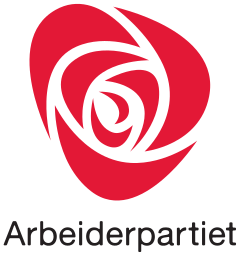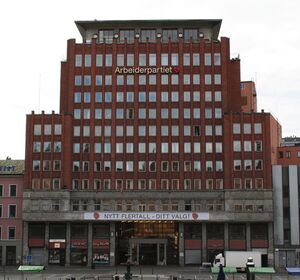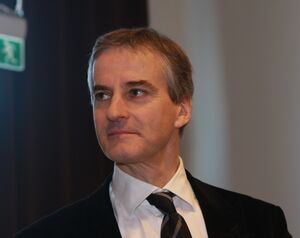حزب العمال (النرويج)
حزب العمال Arbeidarpartiet | |
|---|---|
 | |
| الاختصار | A/Ap |
| الزعيم | يوناس گار ستورى |
| تاريخ التأسيس | 22 August 1887 |
| المقر الرئيسي | Youngstorget 2 A، الطابق الخامس، أوسلو |
| عدد الأعضاء | |
| الأيديولوجية | Social democracy[2] |
| الموقف السياسي | Centre-left[3] |
| الانتماء الأوروبي | حزب الاشتراكيين الأوروپيين |
| الانتماء الدولي | التحالف التقدمي |
| الشعار | "Alle skal med" ("كل واحد سيـُشمَل") |
| الموقع الإلكتروني | arbeiderpartiet |
| سياسة Norway | |
حزب العمال (Bokmål: Arbeiderpartiet؛ Nynorsk: Arbeidarpartiet؛ A/Ap)، وكان سابقاً حزب العمال النرويجي (نرويجية: Det norske Arbeiderparti؛ DNA)، هو حزب اشتراكي-ديمقراطي[4][5][6][7] في النرويج. وكان الشريك الأكبر في ائتلاف الحمر-الخضر الحاكم من 2005 إلى 2013 وزعيمه ينز ستولتنبرگ عمل رئيساً للوزراء. الحزب حالياً يقوده يوناس گار ستورى.
The Labour Party is officially committed to social democratic ideals. Its slogan since the 1930s has been "everyone shall take part" and the party traditionally seeks a strong welfare state, funded through taxes and duties.[8] Since the 1980s, the party has included more of the principles of a social market economy in its policy, allowing for privatisation of state-owned assets and services and reducing income tax progressivity, following the wave of economic liberalisation during the 1980s. During the first Stoltenberg government, the party's policies were inspired by Tony Blair's New Labour agenda in the United Kingdom and saw the most widespread privatisation by any government in Norway to that date.[9] The party has frequently been described as increasingly neoliberal since the 1980s, both by political scientists and opponents on the left.[10] The Labour Party profiles itself as a progressive party that subscribes to co-operation on a national as well as international level. Its youth wing is the Workers' Youth League. The party is a member of the Party of European Socialists and the Progressive Alliance. It was formerly member of the Comintern (1919–1923), the International Revolutionary Marxist Centre (1932–1935), the Labour and Socialist International (1938–1940) and the Socialist International (1951–2016). The Labour Party has always been a strong supporter of Norwegian NATO membership and has supported Norway joining the European Union during two referendums. During the Cold War, when the party was in government most of the time, the party closely aligned Norway with the United States at the international level and followed an anti-communist policy at the domestic level in the aftermath of the 1948 Kråkerøy speech and culminating in Norway becoming a founding member of NATO in 1949.[11]
Founded in 1887, the party steadily increased in support until it became the largest party in Norway at the 1927 parliamentary election, a position it has held ever since. That year also saw the consolidation of conflicts surrounding the party during the 1920s following its membership in the Comintern. It first formed a government in 1928 and has led the government for all but sixteen years since 1935. From 1945 to 1961, the party had an absolute majority in the Norwegian Parliament, to date the last time this has happened in the history of Norway. The electoral domination by the Labour Party during the 1960s and early 1970s was initially broken by competition from smaller left-wing parties, primarily from the Socialist People's Party. From the late 1970s, the party started to lose voters due to a rise in right-wing parties, leading to a swing to the right for the Labour Party under Gro Harlem Brundtland during the 1980s. In 2001, the party achieved its worst results since 1924. Between 2005 and 2013, Labour returned to power after committing to a coalition agreement with other parties in order to form a majority government.[8] Since losing nine seats in 2013, Labour has been in opposition. The party lost a further six seats in 2017, yielding the second-lowest number of seats Labour has held since 1924.
التاريخ

The party was founded in 1887[12] in Arendal and first ran in elections to the Storting in 1894. It entered the parliament in 1903 and steadily increased its vote until 1927, when it became the largest party in Norway. The party were members of Communist International (Comintern), a communist organisation, between 1918 and 1923.[13]
زعماء الحزب

- Anders Andersen (1887–1888)
- Hans G. Jensen (1888–1889)
- Christian Holtermann Knudsen (1889–1890)
- Carl Jeppesen (1890–1892)
- Ole Georg Gjøsteen (1892–1893)
- Gustav A. Olsen-Berg (1893–1894)
- Carl Jeppesen (1894–1897)
- Ludvig Meyer (1897–1900)
- Christian Holtermann Knudsen (1900–1903)
- Christopher Hornsrud (1903–1906)
- Oscar Nissen (1906–1911)
- Christian Holtermann Knudsen (1911–1918)
- Kyrre Grepp (1918–1922)
- Emil Stang jr. (1922–1923)
- Oscar Torp (1923–1945)
- Einar Gerhardsen (1945–1965)
- Trygve Bratteli (1965–1975)
- Reiulf Steen (1975–1981)
- گرو هارلم برونتلاند (1981–1992)
- Thorbjørn Jagland (1992–2002)
- ينز ستولتنبرگ (2002–2014)
- يوناس گار ستورى (2014–الحاضر)
رؤساء الوزراء العماليون
- Christopher Hornsrud (يناير–فبراير 1928)
- Johan Nygaardsvold (1935–1945)[أ]
- Einar Gerhardsen (1945–1951)
- Oscar Torp (1951–1955)
- Einar Gerhardsen (1955–1963)
- Einar Gerhardsen (1963–1965)
- Trygve Bratteli (1971–1972, 1973–1976)
- Odvar Nordli (1976–1981)
- گرو هارلم برونتلاند (فبراير–أكتوبر 1981, 1986–1989, 1990–1996)
- Thorbjørn Jagland (1996–1997)
- Jens Stoltenberg (2000–2001, 2005–2013)
النتائج الانتخابية
| التاريخ | الأصوات | المقاعد | الترتيب | الحجم | |||
|---|---|---|---|---|---|---|---|
| # | % | ± pp | # | ± | |||
| 1894 | 520 | 0.3 | New | 0 / 114
|
New | Extra-parliamentary | 4th |
| 1897 | 947 | 0.6 | ▲ 0.3 | 0 / 114
|
Extra-parliamentary | ||
| 1900 | 7,013 | 3.0 | ▲ 2.4 | 0 / 114
|
Extra-parliamentary | ||
| 1903 | 22,948 | 9.7 | ▲ 6.7 | 5 / 117
|
▲ 5 | ||
| 1906 | 43,134 | 15.9 | ▲ 6.2 | 10 / 123
|
▲ 5 | ▲ 3rd | |
| 1909 | 91,268 | 21.5 | ▲ 5.6 | 11 / 123
|
▲ 1 | ||
| 1912 | 128,455 | 26.2 | ▲ 4.7 | 23 / 123
|
▲ 12 | ▲ 2nd | |
| 1915 | 198,111 | 32.0 | ▲ 5.8 | 19 / 123
|
|||
| 1918 | 209,560 | 31.6 | 18 / 123
|
||||
| 1921 | 192,616 | 21.3 | 29 / 150
|
▲ 11 | |||
| 1924 | 179,567 | 18.4 | 24 / 150
|
||||
| 1927 | 368,106 | 36.8 | ▲ 18.4 | 59 / 150
|
▲ 35 | [ب] | ▲ 1st |
| 1930 | 374,854 | 31.4 | 47 / 150
|
||||
| 1933 | 500,526 | 40.1 | ▲ 8.7 | 69 / 150
|
▲ 22 | (1933–1935) | |
| Minority (from 1935) | |||||||
| 1936 | 618,616 | 42.5 | ▲ 2.4 | 70 / 150
|
▲ 1 | Majority | |
| 1945 | 609,348 | 41.0 | 76 / 150
|
▲ 6 | Coalition (1945, Ap–H–V–Sp–NKP) | ||
| Majority | |||||||
| 1949 | 803,471 | 45.7 | ▲ 4.7 | 85 / 150
|
▲ 9 | Majority | |
| 1953 | 830,448 | 46.7 | ▲ 1.0 | 77 / 150
|
Majority | ||
| 1957 | 865,675 | 48.3 | ▲ 1.6 | 78 / 150
|
▲ 1 | Majority | |
| 1961 | 860,526 | 46.8 | 74 / 150
|
Minority (1961–1963) | |||
| (1963) | |||||||
| Minority (from 1963) | |||||||
| 1965 | 883,320 | 43.1 | 68 / 150
|
||||
| 1969 | 1,004,348 | 46.5 | ▲ 3.4 | 74 / 150
|
▲ 6 | (1969–1971) | |
| Minority (1971–1972) | |||||||
| (from 1972) | |||||||
| 1973 | 759,499 | 35.3 | 62 / 155
|
Minority | |||
| 1977 | 972,434 | 42.3 | ▲ 7.0 | 76 / 155
|
▲ 14 | Minority | |
| 1981 | 914,749 | 37.1 | 65 / 155
|
||||
| 1985 | 1,061,712 | 40.8 | ▲ 3.7 | 71 / 157
|
▲ 6 | (1985–1986) | |
| Minority (from 1986) | |||||||
| 1989 | 907,393 | 34.3 | 63 / 165
|
(1989–1990) | |||
| Minority | |||||||
| 1993 | 908,724 | 36.9 | ▲ 2.6 | 67 / 165
|
▲ 4 | Minority | |
| 1997 | 904,362 | 35.0 | 65 / 165
|
(1997–2000) | |||
| (2000–2001) | |||||||
| 2001 | 612,632 | 24.3 | 43 / 165
|
||||
| 2005 | 862,456 | 32.7 | ▲ 8.4 | 61 / 169
|
▲ 18 | Coalition (Ap–Sp–SV) | |
| 2009 | 949,060 | 35.4 | ▲ 2.7 | 64 / 169
|
▲ 3 | Coalition (Ap–Sp–SV) | |
| 2013 | 874,769 | 30.8 | 55 / 169
|
||||
| 2017 | 801,073 | 27.4 | 49 / 169
|
||||
ملاحظات
- ^ أثناء الاحتلال الألماني للنرويج من 1940 إلى 1945، Johan Nygaardsvold كان في المنفى في لندن.
- ^ Briefly in government from 28 January 1928 to 15 February 1928 until the cabinet was defeated on a vote of no confidence. See Hornsrud's Cabinet.
الهامش
- ^ "Medlemstall" [Members number]. Arbeiderpartiet (in النرويجية). 25 March 2020.
- ^ Nordsieck, Wolfram (2017). "Norway". Parties and Elections in Europe. Retrieved 13 August 2018.
- ^ Jonathan Olsen (2010). "The Norwegian Socialist Left Party: Office-seekers in the Service of Policy?". In Jonathan Olsen; Michael Koß; Dan Hough (eds.). Left Parties in National Governments. Palgrave Macmillan UK. p. 16. ISBN 9780230282704.
- ^ Christina Bergqvist (1 January 1999). Equal Democracies?: Gender and Politics in the Nordic Countries. Nordic Council of Ministers. p. 320. ISBN 978-82-00-12799-4.
- ^ David Arter (15 February 1999). Scandinavian Politics Today. Manchester University Press. p. 71. ISBN 978-0-7190-5133-3. Retrieved 18 July 2013.
- ^ Ari-Veikko Anttiroiko; Matti Mälkiä (2007). Encyclopedia of Digital Government. Idea Group Inc (IGI). p. 389. ISBN 978-1-59140-790-4.
- ^ Richard Collin; Pamela L. Martin (2012). An Introduction to World Politics: Conflict and Consensus on a Small Planet. Rowman & Littlefield. p. 218. ISBN 978-1-4422-1803-1.
- ^ أ ب NRK. "Arbeiderpartiet - Ørnen i Norge". NRK. Retrieved 3 July 2015.
- ^ "Avskjed mellom linjene". www.aftenposten.no (in النرويجية بوكمال). Retrieved 2021-02-21.
- ^ Myten om Gros nyliberalisme, Dagbladet
- ^ Haakon Lie, Norsk biografisk leksikon
- ^ Svennik Hoyer. "The Political Economy of the Norwegian Press" (PDF). Scandinavian Political Studies. Danish Royal Library: 85–141. Retrieved 30 December 2014.
- ^ "Hva historien forteller.. 1920 - 1935". Arbeiderpartiet. Archived from the original on 17 January 2011. Retrieved 17 January 2013.
وصلات خارجية
- Arbeiderpartiet – official website (in نرويجية)
- Norwegian Labour Party – official website (in إنگليزية)
- Election results for the Labour Party in the 2011 local elections
- CS1 النرويجية-language sources (no)
- CS1 النرويجية بوكمال-language sources (nb)
- Short description is different from Wikidata
- Articles containing نرويجية-language text
- Articles containing Bokmål-language text
- Pages using Lang-xx templates
- Articles containing Nynorsk-language text
- Pages with empty portal template
- Articles with نرويجية-language sources (no)
- Articles with إنگليزية-language sources (en)
- حزب العمال (النرويج)
- تأسيسات 1887 في النرويج
- Comintern sections
- Members of the Labour and Socialist International
- Party of European Socialists member parties
- أحزاب تأسست في 1887
- Progressive Alliance
- Second International
- Social democratic parties
- Socialist parties in Norway
- Social democratic parties in Europe
- Organizations that support same-sex marriage

